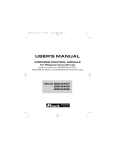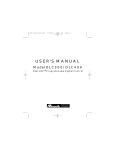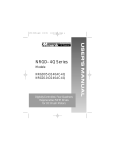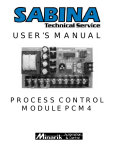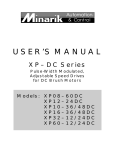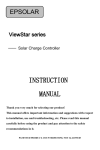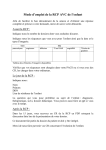Download USER`S MANUAL - Minarik Drives
Transcript
250-0293.qxd 4/13/00 9:40 AM Page a USER’S MANUAL Model VT8 VISI-TACH® Multi-Functional Digital Indicator 250-0293.qxd 4/13/00 9:40 AM Page b Copyright © 2000 by Minarik Corporation All rights reserved. No part of this manual may be reproduced or transmitted in any form without written permission from Minarik Corporation. The information and technical data in this manual are subject to change without notice. Minarik Corporation and its Divisions make no warranty of any kind with respect to this material, including, but not limited to, the implied warranties of its merchantability and fitness for a given purpose. Minarik Corporation and its Divisions assume no responsibility for any errors that may appear in this manual and make no commitment to update or keep current the information in this manual. Printed in the United States of America. 250-0293.qxd 4/13/00 9:40 AM Page i i Safety Warnings • This symbol denotes an important safety tip or warning. Please read these instructions carefully before performing any of the procedures contained in this manual. • DO NOT INSTALL, REMOVE, OR REWIRE THIS EQUIPMENT WITH POWER APPLIED. Have a qualified electrical technician install, adjust and service this equipment. Follow the National Electrical Code and all other applicable electrical and safety codes, including the provisions of the Occupational Safety and Health Act (OSHA), when installing equipment. • Reduce the chance of an electrical fire, shock, or explosion by proper grounding, over-current protection, thermal protection, and enclosure. Follow sound maintenance procedures. Warning Circuit potentials are at 115 VAC or 230 VAC above earth ground. Avoid direct contact with the printed circuit board or with circuit elements to prevent the risk of serious injury or fatality. 250-0293.qxd ii 4/13/00 9:40 AM Page ii 250-0293.qxd 4/13/00 9:40 AM Page iii iii Contents Specifications 1 Dimensions 2 General Information 3 Installation 5 General installation information . . . . . . . . . . . . . . . . . . . . . . . . . . . . . . . . . . . .5 Screw terminal block Mounting . . . . . . . . . . . . . . . . . . . . . . . . . . . . . . . . . . . . . . . . . . .6 . . . . . . . . . . . . . . . . . . . . . . . . . . . . . . . . . . . . . . . . . . . . . . . . . . . .7 Shielding guidelines . . . . . . . . . . . . . . . . . . . . . . . . . . . . . . . . . . . . . . . . . . . .8 Connections . . . . . . . . . . . . . . . . . . . . . . . . . . . . . . . . . . . . . . . . . . . . . . . . . .9 AC Line voltage select switch . . . . . . . . . . . . . . . . . . . . . . . . . . . . . . . . . . . .10 Programming DIP switches 11 . . . . . . . . . . . . . . . . . . . . . . . . . . . . . . . . . . . . . . . . . . . . . . . .12 Encoder power supply (DIP switch #1) . . . . . . . . . . . . . . . . . . . . . . . . . . .13 Feedback select (DIP switches 2 and 3) . . . . . . . . . . . . . . . . . . . . . . . . . .14 Decimal point selection (DIP switches 4, 5 and 6) . . . . . . . . . . . . . . . . . .15 Mode selection (DIP switches 7 and 8) . . . . . . . . . . . . . . . . . . . . . . . . . . .16 Rotary DIP switches . . . . . . . . . . . . . . . . . . . . . . . . . . . . . . . . . . . . . . . . .17 Time base calculations . . . . . . . . . . . . . . . . . . . . . . . . . . . . . . . . . . . . . . .18 Application Examples 23 Mode 1 (tachometer mode) - example 1 . . . . . . . . . . . . . . . . . . . . . . . . . .23 Mode 2 (totalizer mode) . . . . . . . . . . . . . . . . . . . . . . . . . . . . . . . . . . . . .30 Mode 3 (time in process mode) . . . . . . . . . . . . . . . . . . . . . . . . . . . . . . . .32 Mode 4 time in process mode (min:sec or hour:min format) . . . . . . . . . . .34 Unconditional Warranty 37 250-0293.qxd 4/13/00 9:40 AM Page iv iv Illustrations Figure 1. Dimensions . . . . . . . . . . . . . . . . . . . . . . . . . . . . . . . . . . . . . . . . . . . .2 Figure 2. Screw Terminal Block . . . . . . . . . . . . . . . . . . . . . . . . . . . . . . . . . . . . .6 Figure 3. Connection Diagram . . . . . . . . . . . . . . . . . . . . . . . . . . . . . . . . . . . . .9 Figure 4. Line Voltage Select Switch SW501 . . . . . . . . . . . . . . . . . . . . . . . . . .10 Figure 5. VT8 Programming Switches . . . . . . . . . . . . . . . . . . . . . . . . . . . . . . .11 Figure 6. VT8 DIP Switches . . . . . . . . . . . . . . . . . . . . . . . . . . . . . . . . . . . . . .12 Figure 7. Encoder Power Supply DIP Switch . . . . . . . . . . . . . . . . . . . . . . . . . .13 Figure 8. Feedback Select DIP Switches . . . . . . . . . . . . . . . . . . . . . . . . . . . . .14 Figure 9. Decimal Point Location Select DIP Switches . . . . . . . . . . . . . . . . . . .15 Figure 10. Operating Mode Select DIP Switches . . . . . . . . . . . . . . . . . . . . . . . .17 Figure 11. VT8 Rotary DIP Switches . . . . . . . . . . . . . . . . . . . . . . . . . . . . . . . . .18 Figure 12. Mode 1 Example One Switch Settings . . . . . . . . . . . . . . . . . . . . . . .24 Figure 13. Mode 1 Example Two Switch Settings . . . . . . . . . . . . . . . . . . . . . . .29 Figure 14. Mode 2 Totalizer Mode Example DIP Switch Settings . . . . . . . . . . . .31 Figure 15. Mode 3 Example DIP Switch Settings . . . . . . . . . . . . . . . . . . . . . . . .33 Figure 16. Mode 4 Example DIP Switch Settings . . . . . . . . . . . . . . . . . . . . . . . .35 250-0293.qxd 4/13/00 9:40 AM Page 1 1 Specifications Selectable AC Line Voltage (via switch SW501) 115 VAC +/- 10%, 50/60 Hz, 5.5 Watts 230 VAC +/- 10%, 50/60 Hz, 5.5 Watts Selectable Power Supply Output (selected via switch SW502) 5 VDC @ 50 mA 12 VDC @ 25 mA Operating Temperature Range Maximum Input Rate Feedback Frequency Range LED Readout Size 50 mA, Regulated Source, +/- 4% 25 mA, Unregulated Source, +/- 20% 10°C–40°C 20 kHz 10 – 20000 Hz 0.7 inches 250-0293.qxd 4/13/00 9:40 AM Page 2 2 Dimensions Figure 1. Model VT8 Multi-Functional Digital Indicator Dimensions 250-0293.qxd 4/13/00 9:40 AM Page 3 3 General Information Minarik Corporation’s VISI-TACH® model VT8 provides a means for monitoring the speed of rotating shafts using a digital velocity transducer. Speed transducers such as magnetic pickup, optical encoders or hall effect sensors convert motor speed into a small signal frequency which is supplied to the VT8. The VT8 is a multi-functional device and can be programmed for use as a tachometer for display of revolutions per minute, feet per minute, etc. It can also be used as a totalizer, a timein-process monitor with a display of an inverse frequency, or a time-in-process monitor with a time format in hours and minutes, or minutes and seconds. The unit is programmable using a series of switches, located under the rear panel access cover. The variables programmed using these switches are the power supply (5 or 12 VDC), the type of feedback (magnetic pickup or optical encoder), decimal point location, and the mode the unit will operate in. The rotary switches program the time base in seconds. Detailed explanations of each one of these items follow in the programming section of this manual (page 11). 250-0293.qxd 4 4/13/00 9:40 AM Page 4 250-0293.qxd 4/13/00 9:40 AM Page 5 5 Installation Warning Do not install, rewire, or remove this control with input power applied. Doing so may cause fire or serious injury. Make sure you have read and understood the Safety Warnings on pg i before attempting installation. General installation information The VT8 components are sensitive to electrostatic fields. Avoid contact with the circuit board directly. Protect the VT8 from dirt and moisture. Provide adequate clearance for wiring and programming. This takes place at the back of the unit. Mount the VT8 away from other heat sources. Operate within the specified ambient operating temperature range. The operating temperature range for the VT8 is 10ºC through 40ºC. Prevent loose connections by avoiding excessive vibration of the VT8. 250-0293.qxd 6 4/13/00 9:40 AM Page 6 Installation Screw terminal block Connections to Minarik’s VT8 digital indicator are made to a screw terminal block. The screw terminal block has a similar connection style to the one shown below. Using a screwdriver, turn the terminal block screw counterclockwise to open the wire clamp. Insert stripped wire into the wire clamp. Turn the terminal block screw clockwise to clamp the wire. Figure 2. Screw Terminal Block 250-0293.qxd 4/13/00 9:40 AM Page 7 Installation 7 Mounting 1. Cut a rectangular opening 1-25/32 inches [45mm] high by 3-3/8 inches [86mm] wide in your panel. 2. Unscrew the two mounting bracket screws until the threaded end is almost flush with the threaded bushing. 3. Place the VISI-TACH® through the panel opening and install the mounting bracket by engaging the two hooks on each bracket into the two slots on each side of the unit, with the threaded end of the screws towards the back of the panel. 4. Screw the two mounting bracket screws in until they “bite” into the rear of the panel. The screws should be tight enough to prevent the VISI-TACH® from moving, but do NOT over tighten the screws or you may damage your panel. 250-0293.qxd 8 4/13/00 9:40 AM Page 8 Installation Shielding guidelines Under no circumstances should power and logic leads be bundled together. Induced voltage can cause unpredictable behavior any electronic device, including motor controls. As a general rule, Minarik recommends shielding of all conductors. If it is not practical to shield power conductors, Minarik recommends shielding all logic-level leads. If shielding is not practical, the user should twist all logic leads with themselves to minimize induced noise. It may be necessary to earth ground the shielded cable. If noise is produced by devices other than the VT8, ground the shield at the VT8 end. If noise is generated by a device on the VT8, ground the shield at the end away from the VT8. Do not ground both ends of the shield. If the VT8 continues to pick up noise after grounding the shield, it may be necessary to add AC line filtering devices, or to mount the VT8 in a less noisy environment. 250-0293.qxd 4/13/00 9:40 AM Page 9 Installation Connections 1. Connect the AC power line input on terminals L1 and L2. This voltage may be either 115 or 230 VAC. 2. Connect the pickup, encoder or transducer on the terminals as indicated in the drawing below. IMPORTANT: To prevent possible interference do NOT run pickup, encoder, or transducer cable in same conduit as the AC line. Figure 3. Connection Diagram 9 250-0293.qxd 10 4/13/00 9:40 AM Page 10 Installation Line voltage select switch (SW501) ATTENTION: Change voltage switch settings only when the VT8 is disconnected from AC line voltage. Make sure the switch is set to its correct position before applying power. If the switch is improperly set to a lower voltage position, the transformer may be damaged. The VT8 is equipped with line-voltage select switch SW501 (Figure 4). Set this switch to 115 if using a 115 VAC line voltage input. Set the switch to 230 if using a 230 VAC line voltage input. Figure 4. Line Voltage Select Switch SW501 250-0293.qxd 4/13/00 9:40 AM Page 11 11 Programming The VT8 may be programmed before installing it into the panel, and before connecting to the AC line and the pickup, encoder or transducer, or after the entire system is set up. For easier handling, it is usually more convenient to program the VT8 before it is set in the panel. For access to the programming switches, remove the two screws holding the rear cover to the case and remove the cover. The switches are illustrated in Figure 5. Figure 5. VT8 Programming Switches 250-0293.qxd 12 4/13/00 9:40 AM Page 12 Programming DIP switches To change the position of the DIP switches use a small screwdriver to push each DIP switch to the desired position. The DIP switch block has a similar construction style to one shown below (Figure 11). Figure 6. VT8 DIP Switches 250-0293.qxd 4/13/00 9:40 AM Page 13 Programming Encoder power supply (DIP switch #1) DIP switch 1 determines the VT8 power supply output to an external encoder. Set DIP switch to OFF for +5 VDC or ON for +12 VDC to power an optical encoder. For accuracy and current output of this power supply see the specifications on page 1. +5 VDC ENCODER VOLTAGE 12 VDC ENCODER VOLTAGE Figure 7. Encoder Power Supply DIP Switch 13 250-0293.qxd 14 4/13/00 9:40 AM Page 14 Programming Feedback select (DIP switches 2 and 3) DIP switches 2 and 3 are dependent upon which type of feedback has been selected. See the table below for the settings. OPTICAL ENCODER FEEDBACK MAGNETIC PICKUP FEEDBACK Figure 8. Feedback Select DIP Switches 250-0293.qxd 4/13/00 9:40 AM Page 15 Programming Decimal point selection (DIP switches 4, 5 and 6) DIP switches 4, 5 and 6 determine where the decimal point will light in the display. See the table below for the settings. Only one switch may be on at any time. DECIMAL DISPLAY 000.0 DECIMAL DISPLAY 00.00 DECIMAL DISPLAY 0.000 DECIMAL DISPLAY 0000 Figure 9. Decimal Point Location Select DIP Switches 15 250-0293.qxd 16 4/13/00 9:40 AM Page 16 Programming Mode selection (DIP switches 7 and 8) To select the mode in which the VT8 will operate, use DIP switches 7 and 8. Mode 1 (Tachometer mode) Mode 1 is the tachometer mode (DIP switches 7 and 8 OFF). The tachometer mode displays the monitored shaft speed or a multiple of it. The display can be frozen to the last reading by shorting terminal COM to terminal H. Mode 2 (Totalizer mode) Mode 2 is the totalizer mode (DIP switches 7 OFF and 8 ON). In this mode the unit displays continuous count of pulses received from the speed transducer. The display will turn over to 0000 after either 10,000 pulses have been received from the speed transducer or the unit has been reset. The display can be reset to zero by shorting terminal COM to terminal H. Mode 3 (Time in process monitor mode) Mode 3 is the time-in-process monitor mode (DIP switches 7 ON and 8 OFF). This mode displays the time in process (or a linear multiple of it) in seconds. The display in the time-inprocess monitor mode is inversely proportional to the monitored shaft speed. 250-0293.qxd 4/13/00 9:40 AM Page 17 Programming 17 Mode 4 (Time in process monitor mode with time display) Mode 4 is the time-in-process monitor mode (min:sec or hour:min format) (DIP switches 7 and 8 to ON). In this mode the unit displays the number in time format. This display can be used to read minutes and seconds, or hours and minutes. The display can be frozen to the last reading by shorting terminal COM to terminal H. MODE 1 (TACHOMETER MODE) MODE 2 (TOTALIZER MODE) MODE 3 (TIME IN PROCESS MONITOR MODE) MODE 4 (TIME IN PROCESS MONITOR MODE WITH TIME DISPLAY) Figure 10. Operating Mode Select DIP Switches 250-0293.qxd 18 4/13/00 9:40 AM Page 18 Programming Rotary DIP switches The programming variable which determines the display reading is called the time base. The time base is the time interval the VT8 uses to count the pulses from the speed transducer and issue the result to the display. The rotary DIP switches program the time base, in seconds, from 0.01 seconds to 10.00 seconds. Settings of all zeros is equal to a time base of 10.00 seconds. An explanation of the time base calculation begins on page 19. The time base is programmed for modes 1, 3, and 4 only. Figure 11. VT8 Rotary DIP Switches 250-0293.qxd 4/13/00 9:40 AM Page 19 Programming 19 Time base calculations Ideally, the time base should be set between .67 seconds and 2 seconds. If the time base is set below .67 seconds, the display will update too often and tend to flicker. If the time base is set greater than two seconds, the display reading will not update often enough and may lag the actual speed of the application. To program the rotary switches, use a small screwdriver and set the pointer mark to the desired number. The following application variables must be known before calculating the time base (t): DDN = The desired display number. DDN is the known display value at a certain shaft speed (RPM). It should be 4 digits and ignore any decimal point present. RPM = Revolutions per minute of the monitored shaft at the time when the DDN is known. PPR = Pulses per revolution of the pickup, encoder or transducer. This is the number of teeth on the pickup wheel or lines on the optical encoder. 250-0293.qxd 20 4/13/00 9:40 AM Page 20 Programming Mode 1 (tachometer mode) The time base (t) is a variable which scales the RPM of the monitored shaft at the location of the speed transducer. (DDN)(60) t= (RPM)(PPR) The RPM and DDN in the above equation are arbitrary values. Any RPM value may be chosen. The desired display number for the RPM selected is then determined by the user’s application. Mode 2 (totalizer mode) Mode 2 has no time base. Mode 3 (time in process monitor mode) To calculate the time base in mode 3 use the equation below: 60 250,000 t = (DDN)(RPM) X (ppr) 250-0293.qxd 4/13/00 9:40 AM Page 21 Programming 21 Mode 4 (time in process monitor mode (min:sec/hour:min format)) In this mode we must convert the DDN to an hours and minutes (or minutes and seconds) format. This is done with the following equation: DDN = 60X + Y where X = hours and Y = minutes when operating in the hours and minutes mode, and X = minutes and Y = seconds when operating in the minutes and seconds mode. Calculate the time base with the following equation using the DDN calculated with the equation above: 60 250,000 t = (DDN)(RPM) X (ppr) 250-0293.qxd 4/13/00 9:40 AM Page 22 250-0293.qxd 4/13/00 9:40 AM Page 23 23 Application Examples Mode 1 (tachometer mode) - example 1 Application A PK1 magnetic pick up (PPR=30) is mounted on a motor and is connected to a VT8. The VT8 will display the speed of the motor directly. Calculate the required time base. MOTOR Solution Using the equation on page 18 with arbitrary values of RPM=100, and DDN=100 the time base becomes: t= (DDN)(60) (RPM)(PPR) = (100)(60) (100)(30) = 2 seconds This is the standard time base that the factory sets into the VT8 for shipment. See Figure 12 for a diagram of the switch settings for this example. 250-0293.qxd 24 4/13/00 9:40 AM Page 24 Application Examples Figure 12. Mode 1 Example One Switch Settings 250-0293.qxd 4/13/00 9:40 AM Page 25 Application Examples 25 Mode 1 (tachometer mode) - example 2 Application A PK21-30 encoder (30 lines per revolution) is monitoring the speed of a motor with a maximum of 1800 RPM. The pulley on the motor has a radius of 3.75 inches. The user wishes to have the VT8 display the speed of a belt, which is mounted on the pulley, in feet per second. Find: a. The required time base. b. The error due to rounding the time base c. The display range in feet per second if the motor speed ranges from 60 to 1800 RPM. d. A method for lowering the error. 250-0293.qxd 26 4/13/00 9:40 AM Page 26 Application Examples Solution to part a) Start by obtaining a conversion factor between motor speed in RPM to belt speed in feet per second. Use an arbitrary speed of 1 RPM for the calculation. 1 RPM = 1 revolution minute 1 foot 12 inches 1 RPM = 2(π)(r) 1min 1 rev X X X minute 60 sec minute 1 RPM = 1min 2(3.14)(3.75) 1 rev X X X 60 sec minute minute 1 foot 12 inches = .0327 feet per second Now calculate the time base using the equation on page 16: t = (DDN)(60) (RPM)(PPR) = (.0327)(60) (1)(30) = .06545 sec Rounded, the result is 0.07 second. Solution to part b) Calculate the error as follows: % error = rounded value – original value X 100 original value % error = 0.07 – 0.06545 0.06545 X 100 = 6.95% 250-0293.qxd 4/13/00 9:40 AM Page 27 Application Examples 27 Solution to part c) To determine the display range, calculate the minimum (min) and maximum (max) speed in feet per second: 1 RPM = 0.0327 ft./sec. Min speed = 30 RPM = (30 RPM) X 0.0327 ft./sec 1 RPM = 0.98175 feet/second or about 1 foot per second. Max speed = 1800 RPM (1800 RPM) X 0.0327 ft./sec 1 RPM = =58.905 feet/second or about 59 feet per second. This means the display will range from about 0001 to 0059 feet per second. Solution to part d) The error due to rounding may be decreased by increasing the display value by a factor of 10 and introducing a decimal point. To do this set DIP switch DP4 to ON. The VT8 will read a speed of 10 feet per second as 10.0 feet per second. The new time base is calculated as follows: t= (DDN)(60) (RPM)(PPR) = (.327)(60) (1)(30) = 0.654 sec. = 0.65 second (rounded) 250-0293.qxd 28 4/13/00 9:40 AM Page 28 Application Examples % error = = rounded value - original value original value 0.65 – 0.6545 0.6545 X 100 X 100 The new display range is: Min speed = 30 RPM = (30 RPM) X 0.327ft/sec 1 RPM = 9.818 feet/second or about 10 foot per second. Max speed = 1800RPM = (1800 RPM) X 0.327ft/sec 1 RPM =589.05 feet/second or about 589 feet per second. The display will now range from about 0010 to 0589 feet per second, reducing the error by a factor of 10. By placing DIP switch DP4 to ON, the display will read 001.0 to 058.9. The error due to rounding could be decreased by further increasing the DDN by a factor of 10 again and moving the decimal point (01.00 to 58.90). See Figure 13 for a diagram of the switch settings for this example. 250-0293.qxd 4/13/00 9:40 AM Page 29 Application Examples Figure 13. Mode 1 Example Two Switch Settings 29 250-0293.qxd 30 4/13/00 9:40 AM Page 30 Application Examples Mode 2 (totalizer mode) Application A VT8 is set for the totalizer mode with a PK21-30 (30 lines per revolution) encoder. The application speed is 500 RPM. Calculate the output frequency of the PK21-30 and the length of time that the display will count before rolling over. Solution Calculate the output frequency as follows: f= (rev.) (min.) X f= (500) (min.) X (pulses.) X (rev.) (30) (rev.) (1 min.) (60 sec) (1 min.) X (60 sec) = 250 Hz 250-0293.qxd 4/13/00 9:40 AM Page 31 Application Examples The accumulated count is given by the following formula: count = (rate)(time) = (f)(time) = (RPM)(PPR) (time) 60 Solving this equation for time yields the following equation: time = (count) = (f) (10,000) (250) = 40 seconds See Figure 14 for diagrams of the switch settings for this example. There is no time base for mode 2. Figure 14. Mode 2 Totalizer Mode Example DIP Switch Settings 31 250-0293.qxd 32 4/13/00 9:40 AM Page 32 Application Examples Mode 3 (time in process mode) Application A motor, and a variable speed drive are powering a conveyor belt carrying components. A 60 tooth magnetic pick up, mounted to the motor shaft, sends a signal to the VT8. It takes 50 seconds for a component to travel the length of the belt when the motor speed is 1000 RPM. Calculate the required time base to display the time necessary in seconds for the components to travel the length of the belt. Solution It is known that time in process (DDN) is 50 seconds when the motor speed is 1000 RPM. From the equation on page 20 we have: 60 250,000 60 250,000 t = (DDN)(RPM) X (PPR) = (50)(1000) X (60) = 5 sec See Figure 15 for diagrams of the switch settings for this example. 250-0293.qxd 4/13/00 9:40 AM Page 33 Application Examples Figure 15. Mode 3 Example DIP Switch Settings 33 250-0293.qxd 34 4/13/00 9:40 AM Page 34 Application Examples Mode 4 (time in process mode (min:sec or hour:min format)) Application A motor and a variable speed drive are powering a process conveyor. A 60-tooth magnetic pickup is mounted on the back of the motor and sends a signal to the VT8. The VT8 will display the time taken in minutes and seconds for the process to complete. Assume that it takes 3 minutes and 15 seconds to complete the process when the motor speed is 1000 RPM. Calculate the required time base for this application. Solution Using the equation on page 20 we have: 60 250,000 t = (60X+Y)(RPM) X (PPR) 60 250,000 t = [(60)(3)+15)](1000) X (PPR) = 1.28 seconds See Figure 16 for a diagram of the switch settings for this example. 250-0293.qxd 4/13/00 9:40 AM Page 35 Application Examples Figure 16. Mode 4 Example DIP Switch Settings 35 250-0293.qxd Notes 4/13/00 9:40 AM Page 36 250-0293.qxd 4/13/00 9:40 AM Page 37 Unconditional Warranty A. Warranty Minarik Corporation (referred to as “the Corporation”) warrants that its products will be free from defects in workmanship and material for twelve (12) months from date of manufacture thereof. Within this warranty period, the Corporation will repair or replace such products that are returned to Minarik Corporation, 901 East Thompson Avenue, Glendale, CA 91201-2011 USA. This warranty shall not apply to any product that has been repaired by unauthorized persons. The Corporation is not responsible for removal, installation, or any other incidental expenses incurred in shipping the product to and from the repair point. B. Disclaimer The provisions of Paragraph A are the Corporation’s sole obligation and exclude all other warranties of merchantability for use, express or implied. The Corporation further disclaims any responsibility whatsoever to the customer or to any other person for injury to the person or damage or loss of property of value caused by any product that has been subject to misuse, negligence, or accident, or misapplied or modified by unauthorized persons or improperly installed. C. Limitations of Liability In the event of any claim for breach of any of the Corporation’s obligations, whether express or implied, and particularly of any other claim or breech of warranty contained in Paragraph A, or of any other warranties, express or implied, or claim of liability that might, despite Paragraph B, be decided against the Corporation by lawful authority, the Corporation shall under no circumstances be liable for any consequential damages, losses, or expense arising in connection with the use of, or inability to use, the Corporation’s product for any purpose whatsoever. An adjustment made under warranty does not void the warranty, nor does it imply an extension of the original 12-month warranty period. Products serviced and/or parts replaced on a nocharge basis during the warranty period carry the unexpired portion of the original warranty only. If for any reason any of the foregoing provisions shall be ineffective, the Corporation’s liability for damages arising out of its manufacture or sale of equipment, or use thereof, whether such liability is based on warranty, contract, negligence, strict liability in tort, or otherwise, shall not in any event exceed the full purchase price of such equipment. Any action against the Corporation based upon any liability or obligation arising hereunder or under any law applicable to the sale of equipment or the use thereof, must be commenced within one year after the cause of such action arises. 250-0293.qxd 4/13/00 9:40 AM Page 38 901 East Thompson Avenue Glendale, California 91201-2011 Tel.: 1-800-MINARIK (646-2745) Fax: 1-800-394-6334 www.minarikcorp.com Document number 250–0293, Revision 0 Printed in the U.S.A – 2/00 North America $10.00, Outside North America $11.00














































